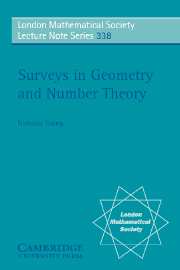Book contents
- Frontmatter
- Contents
- Preface
- Affine embeddings of homogeneous spaces
- Formal groups over local fields: a constructive approach
- Classification problems and mirror duality
- Birational models of del Pezzo fibrations
- Best Diophantine approximations
- Projectively dual varieties of homogeneous spaces
- Equivariant embeddings of homogeneous spaces
- Geometric quantization and algebraic Lagrangian geometry
Classification problems and mirror duality
Published online by Cambridge University Press: 07 May 2010
- Frontmatter
- Contents
- Preface
- Affine embeddings of homogeneous spaces
- Formal groups over local fields: a constructive approach
- Classification problems and mirror duality
- Birational models of del Pezzo fibrations
- Best Diophantine approximations
- Projectively dual varieties of homogeneous spaces
- Equivariant embeddings of homogeneous spaces
- Geometric quantization and algebraic Lagrangian geometry
Summary
Introduction
In this paper we make precise, in the case of rank 1 Fano 3-folds, the following programme:
Given a classification problem in algebraic geometry, use mirror duality to translate it into a problem in differential equations; solve this problem and translate the result back into geometry.
The paper is based on the notes of the lecture series the author gave at the University of Cambridge in 2003. It expands the announcement, providing the background for and discussion of the modularity conjecture.
We start with basic material on mirror symmetry for Fano varieties. The quantum D–module and the regularized quantum D–module are introduced in Section 1. We state the mirror symmetry conjecture for Fano varieties. We give more conjectures implying, or implied by, the mirror symmetry conjecture. We review the algebraic Mellin transform of Loeser and Sabbah and define hypergeometric D–modules on tori.
In Section 2 we consider Fano 3-folds of Picard rank 1 and review Iskovskikh's classification into 17 algebraic deformation families. We apply the basic setup to Fano 3-folds to obtain the so called counting differential equations of type D3. We introduce DN equations as generalizations of these, discuss their properties and take a brief look at their singularities.
In Section 3, motivated by the Dolgachev-Nikulin-Pinkham picture of mirror symmetry for K3 surfaces, we introduce (N, d)-modular families; these are pencils of K3 surfaces whose Picard-Fuchs equations are the counting D3 equations of rank 1 Fano 3-folds.
Information
- Type
- Chapter
- Information
- Surveys in Geometry and Number TheoryReports on Contemporary Russian Mathematics, pp. 88 - 121Publisher: Cambridge University PressPrint publication year: 2007
Accessibility standard: Unknown
Why this information is here
This section outlines the accessibility features of this content - including support for screen readers, full keyboard navigation and high-contrast display options. This may not be relevant for you.Accessibility Information
- 28
- Cited by
